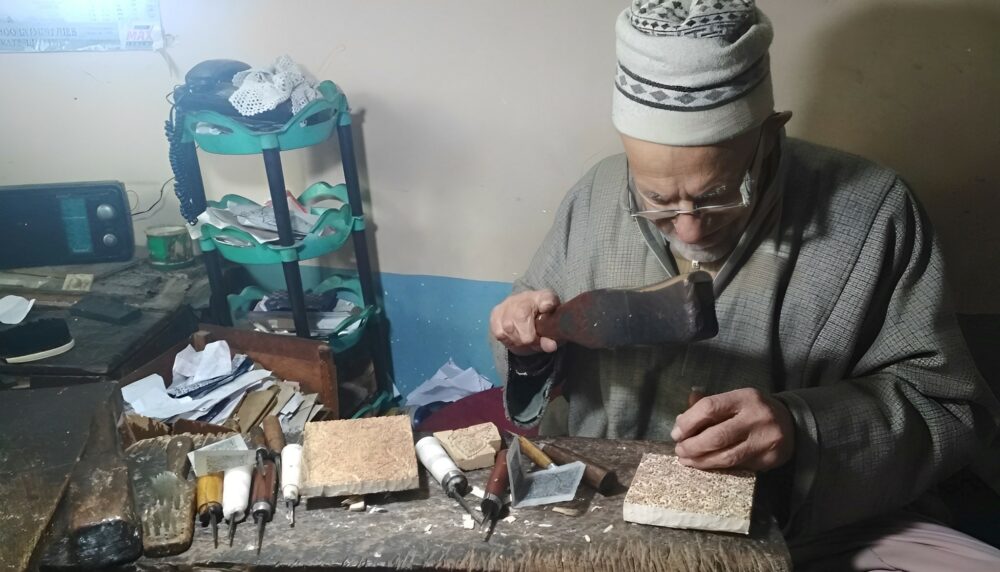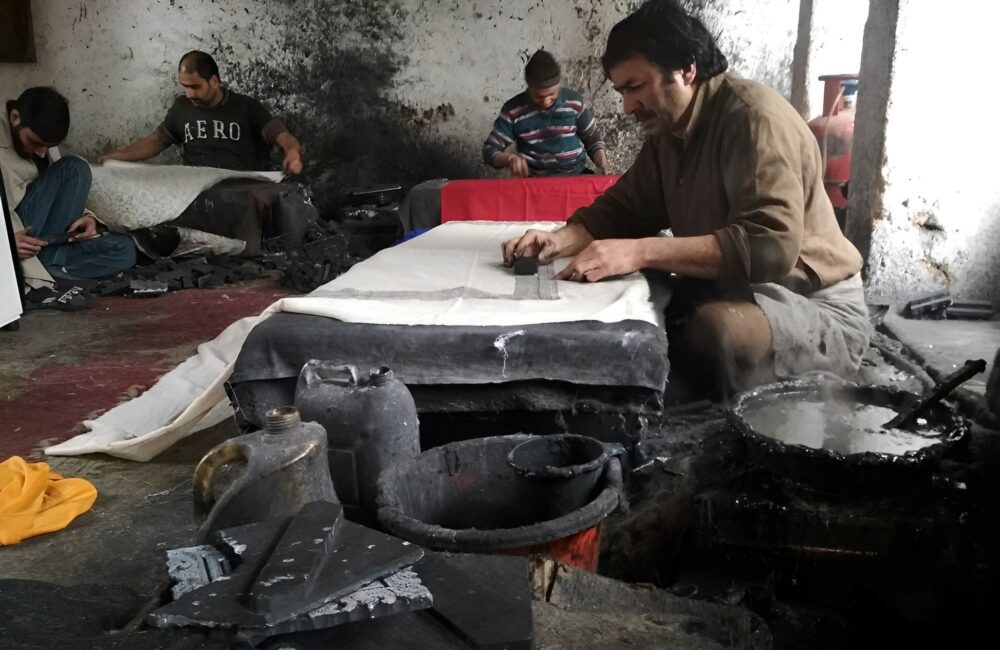[ad_1]
Even though modernity has overtaken the traditional arts associated with handicrafts, some specialities survived the onslaught. Mir Suneem reports the maze where a neglected art form is battling for survival

On a cold winter morning, an old feeble man sits in a small shack separated from his main house by a stretch of garden area at Safa Kadal’s Malik Sahib Chai Dub. His eyes do not lose focus as he works diligently on a small wooden block, contriving designs on it using a gouge and a tapping tool.
The shack converted into a workshop is lit by a high-voltage bulb placed just near the working area for more visibility. Stuffed with tools, equipment, wooden blocks, paper designs and a long table, it hardly provides any space for another person to sit in it.
Ghulam Nabi Wani, a septuagenarian has been carving designs for more than 50 years along with his elder brother Ghulam Ahmad Wani who died several years ago. He carves intricate and sophisticated designs on walnut lumber that are later used by design printers, commonly known as Naqashs for printing Shawls and other clothing items.
In Main City
The art of Naqsh carving is more prominent in Srinagar’s Shehr-e-Khas, the main city. A general belief is that master artisans share this art with their children and do not teach anyone outside their kinship. However, only a few names are presently involved in this business and Ghulam Nabi Wani is one of them.
Belonging to a family of artists with his father doing Tilla work all his life, Wani naturally had an inclination towards arts and crafts. This paved the way to pick woodcarving as his art form and later followed the footsteps of his brothers and established himself as a master carving artist.
“I receive a number of patterns and designs made on butter paper from various Naqashs and whittle a block of wood accordingly to attain that design,” Wani said. “It is a very fine craft and requires skill, patience and immense hard work.”
Most of the designs are convoluted and are meant primarily for Shawl embroidery. “These can only be carved on blocks of walnut wood as no other type can bare the entire treatment and could lose firmness,” Asserts Wani. “Blocks of various measurements are cut from walnut lumber and seasoned and as soon as they are dry, different designs are carved out on them according to the actual designs received on paper using various tools. Then oil is applied to let the blocks set. It is not an easy job and demands a lot of time and concentration.”
Wani believes that art is a secret that everyone cannot unravel. Only those who are passionate can learn it and pass it forward to other generations. “I have taught my son too who is currently also indulged in the handicraft business and I wish him to carry forward my legacy in the future.” He said he is open to teaching anyone but the current generation is impatient and not passionate enough to utilize their time to learn this art.
Reduced Numbers
Other than Wani, only a few people know and practice this art currently. Mohammad Shafi Punjabi who lives in Srinagar’s Rajouri Kadal has been drawing and carving designs himself ever since he grew up but for the last few years, he has not been able to continue this work due to old age and illness.

“Shafi has worked as a prominent and noticeable Naqash for many decades and a number of printers and other Naqashs used to visit him and buy his designs but now due to his illness, he is bed-ridden and no longer does this job,” said Shafi’s wife.
She said that all their children are well educated and settled in their jobs and businesses and none of them has taken up their father’s craft and doesn’t even desire to do so. “It demands a lot of hard work and time and despite that, the income is too meagre that my children decided to do something else for a better living.”
Apart from Shafi’s children, there are many others who dropped the idea of continuing their generation-old craft of Naqashi and chose business or some other job over it.
“There are many factors responsible for pushing this art towards death,” said Zafar Ahmad Ashai, a Naqash (imprinter) from Lalbazar. “One of these is the age-old tradition of keeping the art in the family and not giving it away, and the other reason is the reluctance of new generation kids to learn or pursue this craft as it demands a lot of time and effort with minimal benefits.”
Zafar, originally from Aalikadal learned to print the designs on Shawls and other garments from his elder brother, Mohammad Ashraf Ashai and it has been more than 40 years since he picked the art. He owns a workshop at Srinagar’s Aalikadal where he works along with a few of his employees.
He said even he doesn’t want his children to do Shawl printing when they grow up. “It is a tough and messy job. You have to handle ink and stay in pungent workshops for hours. My children have no interest in this and they are studying in order to do better jobs in the future,” he said.
While talking about the state of this art a few decades earlier when most areas of downtown Srinagar had Naqsh carvers and printers in abundance, Zafar recalls this huge building with ancient architecture that stood between tiny alleys of Maharaj Gunj and was turned into a Naqash workshop by Ghulam Qadir Naqash of Zoonimar who used to draw and carve designs and his brother Ghulam Nabi Naqash who used to print along with many other employees.
“It was the most renowned printing place in those times. The imprinters there used to print hundreds of shawls every day and it was always crowded with handicraft artists and other people who used to visit the place to drop their orders,” Zafar said. “However, several years ago with the death of one of the owners of the workshop and some other unknown reasons, it was closed and the building stays there completely abandoned. People from far away areas still come asking for this once so popular Naqash workshop which doesn’t exist anymore.”
Printing Addresses
On one hand, where Naqsh carvers or designers are going down in number, there are some age-old Naqash workshops that still run successfully in several areas of the city. These are basically just printing places where imprinters from various places of Kashmir regardless of their family jobs work as employees.
A Naqash workshop is wontedly a big dark room with a pungent reek inside it where imprinters work tirelessly to meet their orders. Their grubby and calloused hands are stained with ink and adhesive while they use their bare hands to apply it on patterned blocks to print impressions on Shawls.
Apart from printing various designs on Pashmina, Count and other types of Shawls and stoles, some imprinters also print Sarees, Suits, Pherans, Cushion covers, Ponchos and other garments using various types of designs blocks meant for Sozni, Aari, Tilla work or any other handicraft.
The imprinters mainly have their workshops in Kawdara, Rajouri Kadal, Naid Kadal, Bohri Kadal, Safa Kadal, Nowhatta and other places of Srinagar. However, it is not necessary that the imprinters belong to the same area. There are many who belong to areas outside Srinagar.
Phalguru’s Initiative
One of the workshops Shahnawaz Naqash House was established some 40 years back by an eminent Sozni artist, Habibullah Phalguru who used to draw his own designs on butter paper and send them out for carving on walnut wood. He made the workshop along with his son Shahnawaz Phalguru near his house at Naid Kadal to expand his field of work.
Presently, Shahnawaz works as a businessman and has employed several imprinters to run the workshop. According to him, imprinters don’t have to belong to a particular community or region to take up this field. It is laborious and one who decides to learn and practice it can pursue this job easily.
“I am working here for the last 18 years,” Parvez Ahmad, one of his employees from Pampore said. “None of my family members had any association with any kind of art form but I came here to learn it and now as I have gained expertise in this work, I can teach others too.”
“When the design made on a walnut wood block comes to the printer, he uses it to print all items by applying ink to it. This is no ordinary ink. It is made by the imprinter himself by adding Saresh (a kind of adhesive) to the boiling water. Then its steam is used to moisten the ink they get from the market (which is usually black or white or sometimes blue). This ink is basically carbon or zinc. Earlier, the hay that was collected around chimneys and fireplaces was used as ink. The ink is applied on hand and tapped on the block. Then its impression is pressed on a shawl or any cloth,” explains Parvez.
He said that a design block doesn’t last for very long. The design fades with time and then it is of no use and needs to be re-carved.
The Naqash House
Another huge workshop, Hassan Naqash House lies in the Aalikadal area of Srinagar. Currently run by Showkat Ahmad Naqash,52, it was actually established by his father Ghulam Hassan Naqash who died eight years ago. Hassan used to make and carve designs himself and Showkat still uses the same designs to print Shawls.
“I don’t need to buy new designs from anyone. I still use my father’s designs and get them re-carved once they are weary and non-functional but unfortunately, not more than four designers or carvers are left in Kashmir now,” said Showkat.
He said he studied up to matriculation and then joined his father. Currently, he has several employees working alongside him. However, his children have no plans to get into this field.
It is evident that the arrival of machines into the handicraft industry has affected the artists badly but such a thing has not intervened in the real Naqash world yet. Apart from this, no non-Kashmiri has been able to get into this field so far as it requires a good hand in the craft.
“In some places, people use trace paper for printing but it is not preferred much as it comes with its share of disadvantages. This method is usually used in Tilla work and other related works where it could be concealed with embroidery but not in the case of Shawls and Sozni (needle-art),” said Showkat.
He said that trace paper printing is cheaper and kerosene is used in the process which may lead to many issues. Also, the ink is permanent and cannot be washed away easily.
“Such technique is mostly used outside Srinagar in villages such as Makhama, Beerwa and other places and now it is gradually taking over as only few wood carvers are left to dig into the wood to make designs.”
In the Noorbagh area of Srinagar, there are around 15 trace designers and many non-Kashmiri artisans work there but according to the practising Naqashs, trace printing has no comparison with handmade designing and poses many health risks due to the use of kerosene in it.
[ad_2]
#Kashmirs #Naqashi #Printers
( With inputs from : kashmirlife.net )








